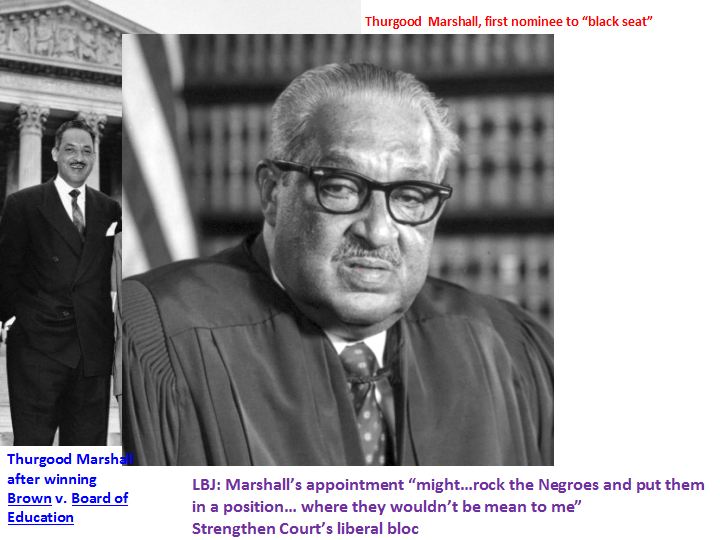By Robert Bernstein
Living With Nixon’s Supreme Court Today
Dr. Laura Kalman
Distinguished Professor of History at UCSB
5-18-19
In public school, history was probably my least favorite subject. All those papers to write. And what was the relevance?
Laura Kalman is Distinguished Professor of History at UCSB. She gave the most recent talk at the Humanist Society. She explained that nearly 50 years after Nixon we are still living with his court. It was clear that the past is often very relevant to current times and that the past often shapes our current choices.

When Scalia died, Obama nominated Merrick Garland to the Supreme Court. Senator Mitch McConnell came up with a phony excuse that the Senate will not consider a nominee appointed during the final year of a presidency.
This partisan delay tactic allowed Trump to appoint Gorsuch to the Supreme Court. This did not change the balance of power on the Court.
But his nomination of Kavanaugh would change that balance of power. Christine Blasey Ford accused Kavanaugh of sexual assault. But the confirmation battle started much earlier.
Over 2400 law professors signed a letter saying that Kavanaugh’s demeanor was disqualifying for a seat on the Supreme Court.

The hearings raised different memories for different groups. Some were reminded of the Clarence Thomas hearings with Anita Hill accusing him of sexual harassment. Others were reminded of the Bork hearings.
What about diversity on the Court? There are three women now. But all are graduates of Harvard or Yale Law School. There are three Jews, three Catholics and one Protestant who was raised Catholic.
How did we get here? As much as Kalman dislikes Pat Buchanan, she is forced to agree with his view: It all began in the 1960s with the Earl Warren court. The Warren court aimed to empower those who were less advantaged.
President Johnson (LBJ) loved it. President Nixon hated it.
The most famous Warren court ruling was Brown v Board of Education which desegregated public schools.

The Miranda case ensuring rights of the accused was the second most famous case.

The far right hated Warren and ran an Impeach Warren campaign. Goldwater made it a campaign issue and failed with it.

Kalman’s story began in 1965. LBJ wanted a spy at the Warren court. He wanted Abe Fortas there. He convinced Goldberg to resign to become UN ambassador. It was seen that two Jews would be too many on the Court!
The inner cities were exploding in flames. LBJ wanted the Court to do something about it. The Court should tell blacks to stop rioting and “turning over cars”!
Some were racializing crime by highlighting white distress. It was a bigger issue than the US war in Vietnam for LBJ’s poll ratings. To achieve the Great Society and the War on Poverty he needed high ratings.
In 1967 LBJ had a second chance on the Court. He wanted Thurgood Marshall. LBJ wanted blacks to be less mean to him and he thought it would help if he created a “black seat” on the Court with Marshall. The Senate had mostly been a lap dog on appointees to the Court.
But Marshall changed that. Strom Thurmond and James Eastland looked like history’s losers when it came to racial equality. But “crime” might win where race might not. So these hostile Southern senators argued against Marshall on Miranda and other crime issues.

Marshall easily won confirmation. Maybe the battle was just to reassure their racist voters. But it had a lasting impact. From then on white supremacy became “law and order”.
In June 1968 LBJ was a lame duck as he would not run again. Nixon made “law and order” and the Warren Court an issue far more successfully than Goldwater did. Nixon began his “Southern strategy” to form a coalition with Southern Democrats.

Warren told LBJ he was retiring. LBJ nominated Fortas to be Chief Justice. He also wanted Thornberry on the court but this was called cronyism. Opponents argued as a lame duck the next president should make the appointment. At first that did not stick.
Thurmond berated Fortas for a decision before Fortas was on the Court! That worked to Fortas’ advantage. It was a case of a black released from death row who went on to commit more crimes. A game changer was needed.
Thurmond seized on the obscenity decision. He showed these obscene films to the senators and reporters. Repeatedly! It worked. Fortas was blocked by filibuster from being Chief Justice. And LBJ’s appointment of Thornberry to the Court was also blocked.
Nixon was then elected and nominated Warren Burger to take the place of Earl Warren as Chief Justice. Warren Burger was a “strict constructionist”. Nixon wanted a former judge rather than a lawyer like Fortas to avoid “crony” claims.
Nixon also did a smear campaign against Fortas. Fortas was the first ever to resign from the Court in disgrace.
This gave Nixon a chance to nominate a replacement for Fortas.
Nixon pushed his Southern strategy by nominating the segregationist Haynsworth to the Court. His ethical lapses were worse than any by Fortas and that was sunk. But Nixon thought it would make his next nomination sail through. No.

His nomination of Carswell would fail, too, when a liberal network uncovered what the FBI missed: That Carswell had championed white supremacy. Even that was not enough. He lost because he was a mediocre judge who had been reversed repeatedly.
Senator Hruska famously said, “Even if he were mediocre, there are a lot of mediocre judges and people and lawyers. They are entitled to a little representation, aren’t they?” It was not a joke.
In 1971 Nixon had a chance to nominate two more members to the Court with Justices Hugo Black and John Harlan both retiring due to bad health.
Nixon needed two nominees quickly. He considered Mildred Lillie. He wanted to break the all-male Court even though Nixon had less kind words about women: “I’m not for women, frankly, in any job. I don’t want any of them around. Thank God we don’t have any in the Cabinet.”
But Lillie was despised and repeatedly reversed. The American Bar Association (ABA) said she was not qualified.
Rehnquist had previously been dismissed as obscure. “Get him baptized and castrated,” the vulgar Nixon suggested to Atty. Gen. John Mitchell. “No, they don’t do that. I mean, they circumcise. No, that’s the Jews.” [From the John Jenkins book on Rehnquist]
Nixon had previously dismissed Lewis Powell as too old. But now he wanted both as the “conservative twins”. But he worried they would turn liberal over time. His scattershot choices didn’t bring the revolution he wanted.
Kalman speculated briefly, imagining if LBJ’s choices of Fortas and Thornberry had succeeded. They may have upheld economic equality and busing and indigent access to abortion. But she swept this aside saying historians avoid counterfactual speculation.
These battles changed the way justices were selected.
Kalman also noted that the Warren Court was a creature of its time. The country was more liberal then and it was not outside the mainstream. Liberals now run from it. Ruth Bader Ginsburg (RBG) spoke against Roe v Wade.
In 1987 liberals mobilized to stop Reagan’s infamous nomination of Bork. Scalia had been confirmed a year earlier with a Republican Senate. In 1987 the Democrats had the Senate. Bork was successfully defeated on ideology with no cover issue.
President Ford nominated John Paul Stevens to the Court and there was outrage he did not consider a woman. Why did the “Jewish seat” disappear? Nixon was anti-Semitic saying that Jews were soft on crime and hung up on civil rights.
Clinton wanted to revive the “Jewish seat” but Ginsburg said no. Being mainstream made these special seats go away.
W Bush nominated Harriet Miers and this was considered cronyism. Kalman noted that cronies have been on the court since John Jay. She claims cronies have been some of the best justices. Obama picked Kagan who was a crony in some ways. She had been clerk to Marshall.
Kalman was asked if in a perfect world the Court would have more or less power. She said as a liberal she would prefer it had less power in the current world. But she is grateful for the Warren Court achievements.
Judy Fontana asked if term limits or a guarantee of each president getting an appointment would help.
Kalman noted that FDR’s threat to “pack the court” by adding additional members to the Court had a positive effect. He was able to get at least some of his progressive program approved as a result of the threat. She thinks that threat is better than term limits for Court members.
HSSB president Roger Schlueter asked how things might have been different for Nixon if Fox was around then. Kalman agreed it might have been different. The media then was definitely more liberal in her view.
Sylvelin asked about Trump’s packing of lower courts. Kalman said she mostly studies the Supreme Court but agrees it is distressing.















Well, that is one way to look at things.
The Dred Scott case showed how the Supreme Court has always been a political pawn of powerful interests. By 7-2 they upheld the idea that blacks could be enslaved. Their decision almost certainly led the most violent war in US history that continues to this day. https://www.history.com/this-day-in-history/supreme-court-rules-in-dred-scott-case
Lifetime on the court should be changed. I agree with the 15-20 years suggestion. It is just so incredibly political it really isn’t “justice” at all.
TimeMagazine.com: “In 2013, Reid invoked the “nuclear option,” a historic move that changed a long-standing Senate rule, dropping the number of votes needed to overcome a filibuster from 60 to a simple majority for executive appointments and most judicial nominations — a decision he justified because of trouble getting through court confirmations in the latter half of the Obama Administration. At the time, then-Senate Minority Leader Mitch McConnell and many other Republicans warned Reid that he would regret implementing the nuclear option.”////////////////////////////…..and you truly okay with changes the rules again? Really?
I won’t at all. lol
In order to gain a wider perspective, I recommend that people read a new publication by Michael Bobelian titled, Battle for the Marble Palace: Abe Fortas, Earl Warren, Lyndon Johnson, Richard Nixon and the Forging of the Modern Supreme Court. It is a narrative account of the politicization of the Supreme Court and the revolution it sparked in the confirmation process.
So, what does it say that is different than this detailed and well-researched account?
To “Rally the Troops” based on societal “norms” of DECADES ago, that have long been erased is really an intelligent thing to do.
If trump gets another chance at an appointment to the Supreme Court, we are all screwed for a long loooooong time.
It shouldn’t be a lifetime appointment. Mandatory “retirement” after 15 or 20 years serving, and a minimum of 15 years of rulings in a lower court to be considered so any political lean or bias unbefitting the high court would be well-known and documented and the candidate disqualified on grounds.
We can fix the Supreme Court by getting rid of the unrepresentative Senate, which was implemented so that the small southern states could stop the northern states from abolishing slavery. Or my personal favorite, seceding from the Union and becoming our own nation with the 5th biggest economy of the world. If Trump gets re-elected, secession is going to look really good.